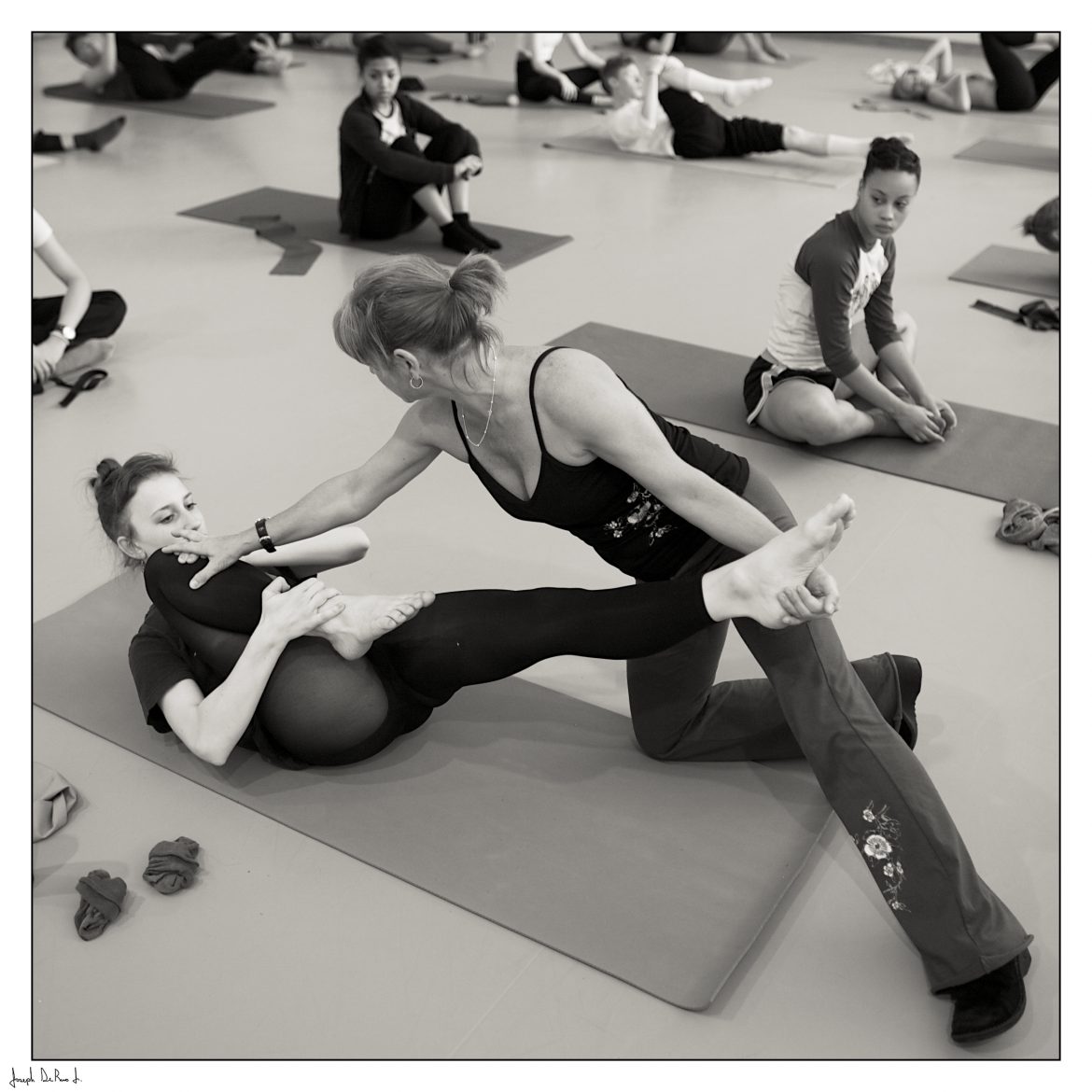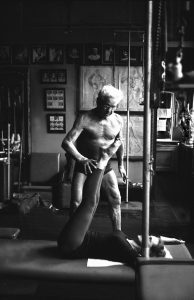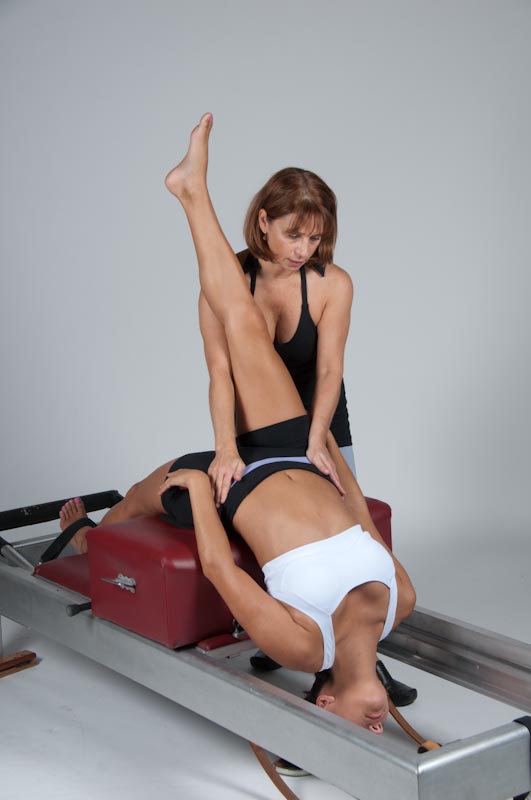 Why should a Pilates Instructor Become Certified in Manual Therapy?
Why should a Pilates Instructor Become Certified in Manual Therapy?
- At first, it might not seem intuitive that a Pilates Instructor should consider working toward a Certification in Manual Therapy. After all, Pilates Instructors are in the world of Movement Therapy, not Manual Therapy. However, there are actually many reasons why they should consider this.
- Joe Pilates was effectively a Manual Therapist. If we watch the old archival footage of Joe Pilates working with clients, we see that he had his hands all over the clients, cueing, directing, stabilizing, and/or augmenting their range of motion through the exercises. Unfortunately, this aspect of The Art and Science of Contrology (Pilates as we currently call it today) has largely been lost. Most Pilates Instructors nowadays tend to stand back and verbally direct their client about what exercises to do and how to do them.
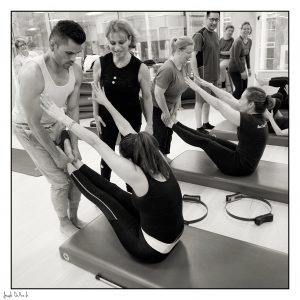 Manual Therapy Improves Movement Therapy. As mentioned above, when Joe Pilates or any Pilates Instructor places their hands on a client, it is done to improve the client’s ability to perform the exercise. This is especially true for clients who are kinesthetically oriented.
Manual Therapy Improves Movement Therapy. As mentioned above, when Joe Pilates or any Pilates Instructor places their hands on a client, it is done to improve the client’s ability to perform the exercise. This is especially true for clients who are kinesthetically oriented.
- Cueing: Hands-on touch with a client can be done to proprioceptively cue the client so they know where to direct their intention of engagement of where they should “feel” the exercise. For example, if a client is not engaging their glutes during an exercise, gently touching the gluteus maximus can direct their nervous system to proper facilitation of engagement of that musculature. Or if the client is being asked to bring their spine back to the mat “one vertebra at a time,” gently laying your hands on the thoracic region can signal their nervous system to articulate and move that region as needed. Beyond all this, if we can direct our clients as to where they should “feel” the exercise, they will better be able to perform these exercises safely and effectively at home.
- Directing Motion: Placing our hands on the client’s body as they are moving through the motion of the exercise can help to direct them to move the correct body part in the appropriate direction. If we teach with only verbal direction, we need to have the verbiage that will convey 3D motions to the client; and the client needs to be able to understand and mentally picture how those words relate to their movement. Verbalizing movement patterns in words can be challenging for both the instructor and the client! Instead, if we place their hands on the client and gently guide them through the appropriate direction and range of motion, the client can “feel” this motion within their body and immediately gain an understanding of the exercise from within. This is especially important for clients who are kinesthetically oriented, which most clients of any exercise method are.
- Stabilizing the Client. One of the major tenets of Pilates is to move one body part as another body part moves in space. This can be challenging even for an experienced athlete, let alone a novice client. To help the client kinesthetically feel the rooting/stabilization of the body part, our hands-on assistance is extremely important.
- Augmenting the Motion. Hands-on manual touch by the Pilates instructor can also be done to augment the range of motion by the client during an exercise. Most every Pilates exercise involves both strengthening and stretching. And stretching is performed at the end of range of motion of a body part at a joint. By gently but firmly and skillfully guiding the client to increase their range of motion during an exercise, we can help the client greatly increase the benefit of the stretch of that exercise.
- Manual Therapy and Movement Therapy Go Together. It is unfortunate that in the United States, the worlds of manual and movement therapy have become so segregated. The best therapist/instructor is one who has the ability to marry together manual and movement therapy!
- Touch is Reassuring. Finally, it should be said that in our touch-deprived world, the simple act of safe and healthy touch by the Pilates instructor can be reassuring to the client, especially the new client who is nervous and insecure about her/his ability to perform the exercises well.
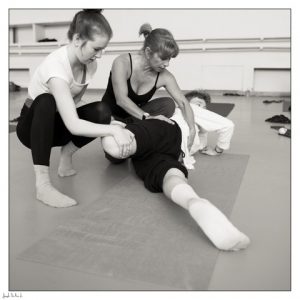 Manual Therapy needs to be Skillful. For all the benefits of the addition to our Pilates practice that we just listed above, our ability to employ manual hands-on therapy must be skillful to be effective. A good Manual Therapy Certification program incorporates anatomy and physiology as well as palpation and orthopedic assessment as part of the curriculum. This can aid in our ability to understand not only which muscle groups should be engaging and which ones are lengthening and stretching, but also how to better located these muscles and myofascial tissues.
Manual Therapy needs to be Skillful. For all the benefits of the addition to our Pilates practice that we just listed above, our ability to employ manual hands-on therapy must be skillful to be effective. A good Manual Therapy Certification program incorporates anatomy and physiology as well as palpation and orthopedic assessment as part of the curriculum. This can aid in our ability to understand not only which muscle groups should be engaging and which ones are lengthening and stretching, but also how to better located these muscles and myofascial tissues.
- Manual Therapy needs to be Safe.
- This may be the one most important reason for working toward and earning a Manual Therapy Certification.
- When manual therapy is incorporated into the Pilates session to augment the range of motion of the exercise, if the Pilates Instructor does not have the ability to feel tissue tension barriers, she or he might push the client too far, thereby injuring the client by either tearing (straining or spraining) myofascial tissue, or kicking in a muscle spindle stretch reflex, thereby causing a reflexive muscle spasm.
- Either of these cases, beyond hurting the client, will also likely result in a loss of trust and confidence on the part of the client for you as their instructor, and also a loss of trust and belief in the Pilates Method of Body Conditioning.
- If, on the other hand, you stay extra cautious with your hands-on guidance when augmenting the stretch motion, you will be sacrificing the effectiveness of the potential benefit of the exercise, thereby rendering your teaching less effective and therefore mediocre.
- Gaining the experience to feel tissue tension mechanical barriers during a Manual Therapy Certification training program can immeasurably improve both the safety and effectiveness of your Pilates instruction!
- Pilates is kinesthetic. Verbal talking to direct your client is not. Hands-on Manual direction is. Plain and simple, Pilates is a kinesthetic endeavor. For this reason, being able to place your hands on the client safely and effectively can aid their kinesthetic sense and will vastly improve the quality of your instruction and their performance. Not every client can translate your words into motion. Most clients need to “feel” the exercise, to “get” the movement. Gaining a confidence in your hands-on skills will allow you to better help the client feel and attain their kinesthetic movements.
Pilates is all about the quality of the client’s motion pattern.
(All other photo credits: The Art of Control.)
Manual therapy hands-on teaching improves that quality!
- Distinguish Yourself.
- Learning any advanced continuing education skill not only improves your ability to teach your clients, it also distinguishes you from the other instructors in the area.
- After all, why should a potential client come to you and your studio when there may be so many other Pilates instructors and studios to choose from?
- Or perhaps a better question might be: Why should a potential Pilates client come to you when they have the choice of going instead to a yoga instructor, personal trainer, or one of so many other types of fitness instructors that are out there?
- Being credentialed will help your business.
- It is estimated that beginning Pilates Instructors in the United States make between $15,000.00 and $23,000.00 per year; and experienced Pilates instructors on average earn between $32,000.00 and $50,000.00 per year (according to LiveStrong: http://bit.ly/2trGcsU). Another estimate is that the average hourly pay in the US for a Pilates Instructor ranges between $29.95 (http://bit.ly/2tBmO0Q) and $32.50 (http://bit.ly/2trGcsU).
- Although these numbers are not bad, they certainly do not allow for a very comfortable standard of living given the costs of living in the US.
- Simply put, more qualifications and more credentials allow you to distinguish yourself, better help your clients, and create a more successful business.
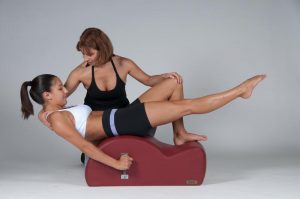 What Type of Manual Therapy Certification Should I Earn?
What Type of Manual Therapy Certification Should I Earn?
- There are many choices when it comes to earning a CE Manual Therapy Certification. Each one requires time, effort, and money, so you should choose wisely.
- Some of your choices revolve around the content of the skillset area: Should it be on assessment or treatment? Should it be on energy work or orthopedic work? Do you want to study on-line or live in-person? Do you want a short certification or a more intensive long one? Do you want to learn a “proprietary technique” that is based on one person’s view on how things should be done or would you prefer studying a more open and expansive approach that might include many viewpoints and philosophies?
- Ultimately some of these are decisions that you must make are based on your style of practice, your desires, and your ability to devote your resources. But given the nature of the Pilates Method of Body Conditioning, it is in the best interest of a Pilates instructor to seek out a Clinical Orthopedic Manual Therapy Certification.
- And given that many Manual Therapy Certification programs might be geared toward current manual therapists (such as massage therapists) who already have comfort with hands-on skills, it is important for you to seek out a Certification that involves live in-person training, for at least a good portion if not all of the training.
- Also, given that Pilates training certification programs usually have little or no anatomy and physiology (kinesiology) training, it is equally important for you to seek out a program that involves an understanding of the underlying musculoskeletal (perhaps a better terms is: myo-fascio-skeletal) anatomy and physiology involved.
- But whatever your choice, make sure that the person or organization that stands behind your Certification program has not only excellent content, but also integrity and respect.
- Summing this up, the Pilates Instructor should find a Manual Therapy Certification Program that incorporates musculoskeletal anatomy and physiology, along with an understanding of common musculoskeletal pathologic conditions, along with some sense of how to recognize and assess these conditions, along with how to safely and effectively use hands-on manual therapy for their clients, both healthy clients as well as those clients with musculoskeletal conditions. A Clinical Orthopedic Manual Therapy Certification program accomplishes all these needs.
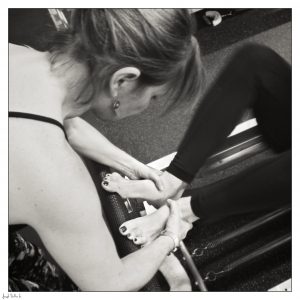 What are the Technique Skillsets taught in a Clinical Orthopedic Manual Therapy (COMT) Certification?
What are the Technique Skillsets taught in a Clinical Orthopedic Manual Therapy (COMT) Certification?
- Hands-on Palpation assessment
- Hand-on Orthopedic assessment
- Postural and movement assessment
- Hands-on practice feeling tissue tension barriers, including “end-feel” for joint motion
- Body mechanics for soft tissue manipulation (massage)
- Hands-on stretching techniques, including pin and stretch and advanced neural inhibition stretching techniques:
- Proprioceptive neuromuscular facilitation (PNF) aka Contract Relax (CR) aka Post-Isometric Relaxation (PIR)
- Agonist Contract (AC)
- Hands-on Grade IV Joint Mobilization (sometimes referred to as arthrofascial stretching)
- Client communication and treatment planning and strategy
- And perhaps most importantly, “brains-on” marrying of the fundamental underlying anatomy and physiology along with the manual and movement therapy skills so that you will learn how to critically think and reason!
Philosophy of Clinical Orthopedic Manual Therapy Certification
What is most important in any Clinical Orthopedic Manual Therapy Certification program is marrying together the underlying science with the hands-on skills. This allows the instructor to understand and critically think so that they can creatively apply their manual and movement therapy techniques.
GOOD HANDS + GOOD MIND = GREAT INSTRUCTOR!
Unfortunately, many training programs tend to teach via cookbook recipes, which shuts down the brain and leaves the Pilates Instructor helpless when the client’s presentation and response do not follow textbook recipes. For this reason, it is important to do your homework and find an excellent Manual Therapy Certification program.
Choices for Clinical Orthopedic Manual Therapy Certification programs
Following are some well-known individuals and organizations that offer Clinical Orthopedic Manual Therapy Certifications.
(Note: Many other fine certifications exist. I have simply listed a few with which I am familiar that are excellent.)
- Art and Science of Kinesiology’s Clinical Orthopedic Manual Therapy (COMT) Certifications. There are two Introductory Level 1 Certifications and one Advanced Level 2 Certification.
- (Level 1) COMT Intensive Certification, which organizes the work throughout the body by region
- (Level 1) COMT Intensive Skillset Certification, which organizes the work by skillset
- (Level 2) COMT Master Class Certification
- Digital COMT is a video streaming subscription service that covers all manual and movement therapies, including Pilates. New video content is uploaded each and every week.
- Full disclosure: The Art and Science of Kinesiology is my (Joseph E. Muscolino’s) organization. For more information about me and The Art and Science of Kinesiology, please visit my website.
- Note: Because of my association with Simona Cipriani, a Second-Generation Pilates Instructor with 20+ years teaching experience, my training program is especially well suited for Pilates Instructors with an interest in adding manual therapy skills to their practice.
- Click here for more information on Simona Cipriani and The Art of Control.
- Tom Myers’ KMI Training
- Whitney Lowe’s Academy of Clinical Massage
- Erik Dalton’s Myoskeletal Technique


